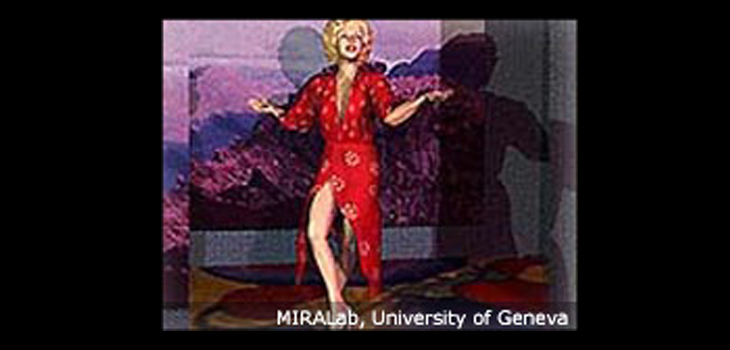
FNRS2000 – “Swiss National Research Foundation Project: An integrated methodology for simulating body and clothes”
Overview
Since 1989, we have made a considerable research work on virtual humans. Our recent focus has been on the modeling and simulation of a virtual human, as decided in our previous FNRS proposal. The modeling of a human face has reached a mature status. Similar techniques to reconstruct the body model will be developed and integrated with the face modeling.
MIRALab’s contribution
The animation of different parts of virtual humans has been investigated and implemented – face, body, hand and clothes, with specific methods for each. During our actual research, however, we have encountered in several aspects with limitations in bringing a true realism onto our virtual humans. One of the main vulnerable points was in the body animation part. Our current body motion, being based on a magnetic motion capture system, needs to be improved and intelligently adapted in terms of the interaction with virtual environment since the methodology as it is requires a lot of interactive work. Skin deformation, which is another important aspect of the body animation, has been considered as a passive entity to the skeleton movement so that it is difficult to get a realistic simulation result as a whole.
On the cloth animation side, even though our efficient techniques to manage complex animated garments with simplified mechanical models allow the reproduction of the main elastic features of the baric materials, it has been always quite difficult for a garment designer to define which value would render the desired result, particularly when using the large possible parameter combinations supported by advanced simulation models. All things considered, we have concluded that accurate capturing/tracking devices are essential components for measuring, capturing and analyzing motion and deformation of real objects in order to simulate their virtual counterparts accurately and realistically in computer graphics applications. Optical motion capture brings a new dimension to these applications, with which actual movements of a subject can be measured, quantified with a substantial accuracy level. Our fundamental research on body animation out of the captured data will be followed by the development of an integrated methodology with skin deformation to automatically adapt the motion to simulate our photo-cloned body model interacting with the virtual environment in a realistic way.
One of the most recent and active research area, namely motion editing, is relevant here and apparently it is a complex task that will need several years to be achieved. This also applies for cloth simulation, which involves accurate motion modeling of the garment cloth, as well as the underlying body. Modeling parameters for simulation can be extracted and validated by quantitative comparison to reality. The main orientations consist in motion modeling through a better characterization of the parameters that rule object motions, a validation of actual models through comparison with real phenomena. As a result, anyone should be able to be realistically cloned and ready to act in any virtual environment.
Partners
MIRALab, University of Geneva
Switzerland
www.miralab.ch
